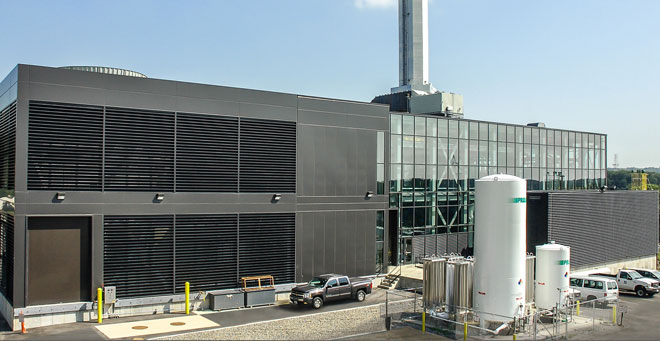 |
|
|
This Energy Star CHP Award recognizes the medical school’s third and most recent CHP expansion: the addition of a 7.5 MW natural gas-fired combustion turbine generator. |
UMass Medical School was recognized by the U.S. Environmental Protection Agency with the Energy Star Combined Heat and Power Award for the superior performance of its combined heat and power (CHP) systems. The Maine Army National Guard in Bangor, Maine; South Oaks Hospital in Amityville, N.Y.; and the University of Maryland Upper Chesapeake Medical Center in Bel Air, Md. were also recognized. The awards were presented by the EPA on Wednesday, Dec. 7, at the New York State Energy Research and Development On-site Power Conference & Expo in New York City.
“Today’s award winners demonstrate how CHP can save money and reduce pollution, a real win-win for the bottom line and the environment,” said Janet McCabe, acting assistant administrator for EPA’s Office of Air and Radiation. “Onsite power generation, like CHP, can also strengthen our nation’s electrical infrastructure.”
High-efficiency CHP technology reduces emissions of carbon dioxide and other air pollutants by capturing the heat produced during electricity generation, which would otherwise be wasted, and using it to provide zero-emission space heating, cooling, hot water and steam for commercial, institutional and industrial use.
UMMS relies on CHP to help power the Worcester campus, which hosts more 7,300 employees and 2,900 visitors daily. This Energy Star CHP Award recognizes the medical school’s third and most recent CHP expansion: the addition of a 7.5 MW natural gas-fired combustion turbine generator, designed and installed with the assistance of Waldron Engineering & Construction.
With a thermal efficiency of 73 percent, the new CHP unit requires approximately 20 percent less fuel than conventional separate electricity and steam production. The reduced fuel use avoids emissions of more than 21,000 tons of carbon dioxide annually, equal to the emissions from the generation of electricity used by more than 2,800 homes. In addition to reduced emissions, the system strengthens the regional transmission and distribution infrastructure by generating electricity on site.
The expanded power plant generates up to 90 percent of the campus’s electricity needs. Because the plant’s electrical output is responsible for less carbon pollution than grid-supplied electricity, the facility receives substantial payments through Massachusetts’ Alternative Portfolio Standard program. The plant reduces the facility’s cost of energy services by approximately $3 million annually.